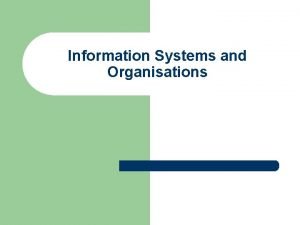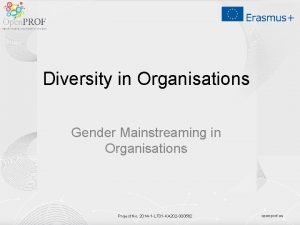Chapter 22 Impact of Organisations Learning Outcomes Upon












- Slides: 12


Chapter 22

Impact of Organisations

Learning Outcomes Upon completion of this chapter you should be able to: • Understand the benefits that organisations bring to society and the economy • Recognise the possible negative impacts of an enterprise on a community.

Types of Impact An organisation’s impact on a community can be: • Positive: when it benefits a community • Negative: when it involves costs or a loss to the community

Types of Organisation • A commercial organisation aims to make a profit. Most businesses are commercial organisations. Examples include banks, shops and airlines. • A non-commercial organisation has not been set up for the sole purpose of making a profit. The not-for-profit sector includes many charities and voluntary organisations that provide a range of services and benefits to communities. • Organisations can be local, national or international.

Economic Benefits of Organisations • Employment: direct and indirect jobs created • Tax Revenue: organisations will contribute to local authority rates • Improved Standard of Living: employees will have disposable income • Multiplier Effect: extra income in an area leads to increased spending • Economic Growth: increase in goods/services produced • Balance of Payments: increase in goods/services produced in Ireland may lead to a reduction in imports or increase in exports

Social Benefits of Organisations • More local services to provide for the needs of organisations can also be used by local people. • Increased Choice/Lower Prices for Consumers: new organisations provide extra goods and services and choice • Promotes Enterprise Culture: seeing local entrepreneurs can encourage others to establish businesses • Improved Quality of Life: successful social and cultural enterprises improve community spirit

Environmental Benefits of Organisations • Pollution Controls: new developments have to obey strict rules to limit pollution • Recycling Facilities: some businesses use rainwater harvesting and recycling to reduce their consumption and environmental impact. • Energy Efficiency: industry is increasingly using renewable energy • Land Usage: organisations make use of vacant land to develop community services. Local authorities provide parklands and sporting organisations develop land to improve local facilities.

Negative Impacts of Organisations • Customers: producing poor quality goods, not protecting personal details • Employees: inadequate health and safety training, unfair wages, making employees redundant • Suppliers: not paying for goods on time, seeking large discounts • Government: not paying appropriate taxes, disobeying laws • Society and Local Community: noise, air, and land pollution

Judging the Success of an Enterprise • Staff Relations • Customer Loyalty • Size of Business • How Long the Business Has Survived • Comparison with Competitors • Awards • Social and Environmental Responsibility

Recap and Review Can you do the following? • Understand the benefits that organisations bring to society and the economy • Recognise the possible negative impacts of an enterprise on a community
 Expected outcome example
Expected outcome example Water cycle learning outcomes
Water cycle learning outcomes Notice writing learning objectives
Notice writing learning objectives Swot analysis objectives
Swot analysis objectives Objective of rhymes
Objective of rhymes Planning goals and learning outcomes
Planning goals and learning outcomes Learning outcomes of photosynthesis
Learning outcomes of photosynthesis Learning outcomes of nutrition in plants
Learning outcomes of nutrition in plants Ncbts
Ncbts Learning objectives of linear equations in one variable
Learning objectives of linear equations in one variable A machine that converts mechanical energy into electricity
A machine that converts mechanical energy into electricity Learning outcomes of reported speech
Learning outcomes of reported speech Purpose of learning outcomes
Purpose of learning outcomes























